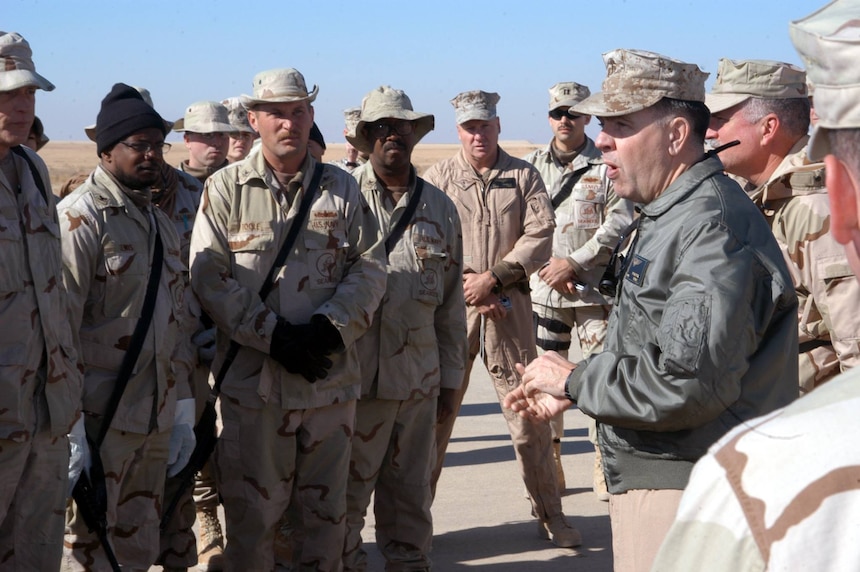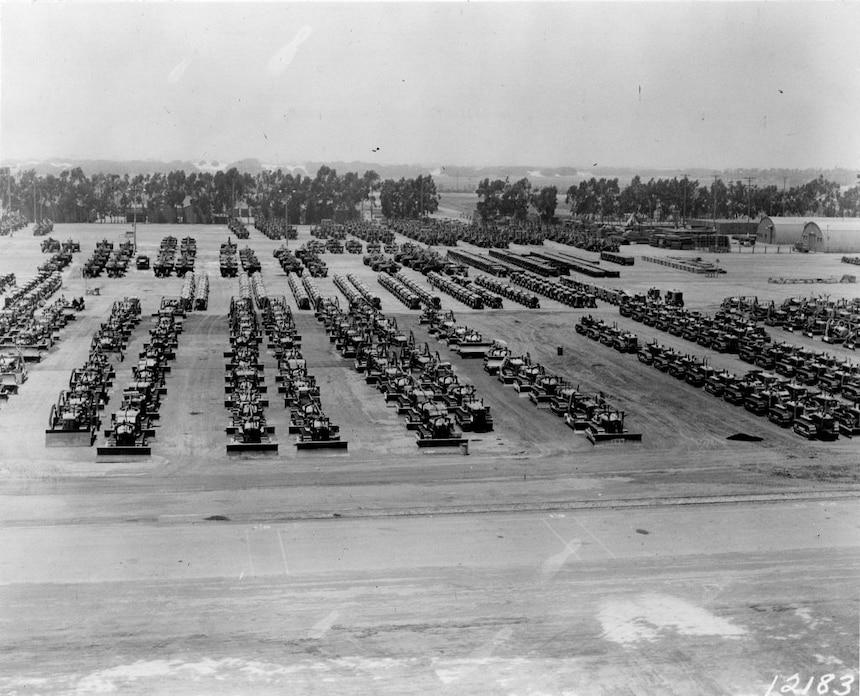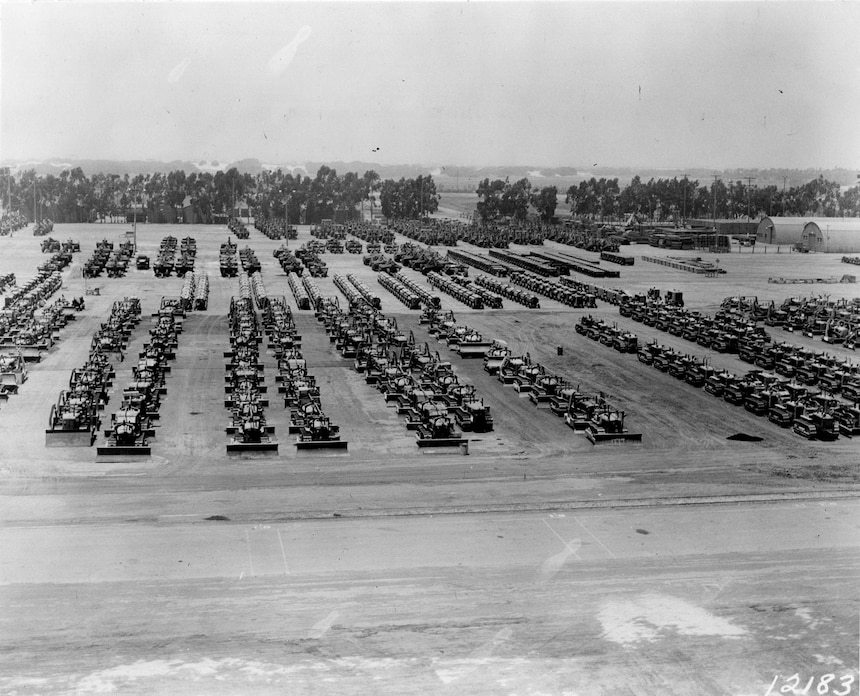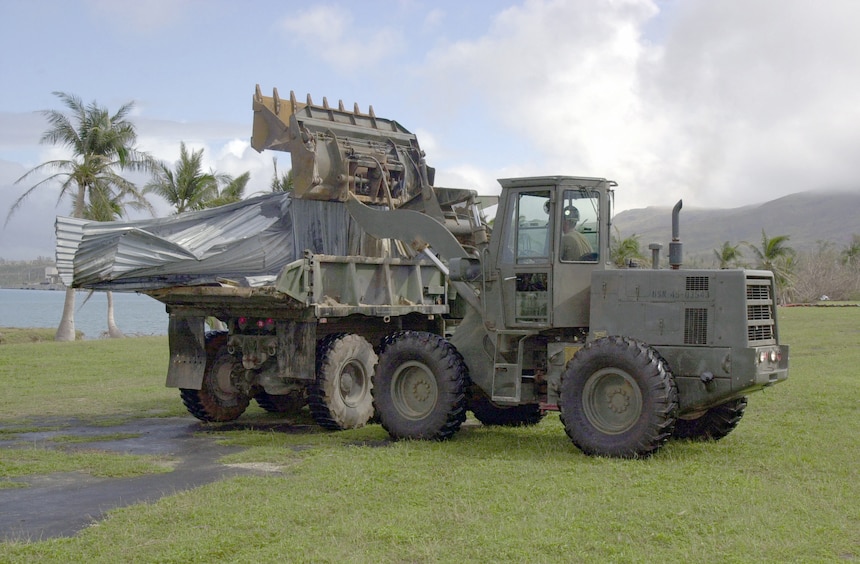Consolidated by U.S. Navy Seabee Museum, Naval History and Heritage Command
December 5
1945: 7th Naval Construction Regiment (NCR) inactivated. 13th Naval Construction Battalion (NCB) inactivated on Okinawa. 43rd NCB inactivated at Nagasaki, Japan. 116th NCB inactivated at Sasebo, Japan.
1966: Seabee Team 0910 departed the main body at Da Nang, Republic of Vietnam (RVN) via C-118 aircraft for the 31st NCR to commence military and technical training.
1967: At a convoy passing site, Naval Mobile Construction Battalion (NMCB) 3 personnel were involved when four mines exploded simultaneously. (They were believed to have been command-detonated dud bombs.) Several Seabees were knocked down by the blast and one carried 40 feet through the air. Unbelievably, no casualties were sustained.
1967: Rear Admiral James V. Bartlett, commander of the 3rd Naval Construction Brigade, dedicated Camp Wilkinson in memory of Construction Mechanic 1st Class J.W. Wilkinson, killed during a mortar attack on the Phu Bai/Gia Le bases. Camp Wilkinson was the Seabee camp at the Gia Le Combat Base near Phu Bai, Vietnam.

Throughout December
1994: The main effort in Cuba was Operation "Sea Signal" during which Joint Task Force 160 constructed facilities to improve the quality of life of Cuban migrants at Guantanamo. By order of the 2nd Naval Construction Brigade, the 22nd Naval Construction Regiment (Forward Element) deployed to Guantanamo with Naval Mobile Construction Battalion 4 and an air detachment from Naval Mobile Construction Battalion 7. As directed by the U.S. Atlantic Command, the senior leadership of the 22nd Naval Construction Regiment (Forward Element) met with engineers from the Naval Facilities Engineering Command's Atlantic Division to develop preliminary designs for the $35 million Quality of Life Improvement Program for 20,000 Cuban migrants.
The original plan called for the construction of 37 migrant villages arranged in 11 village clusters at two locations: Radio Range and McCalla Field, approximately seven miles apart. Migrant riots in Panama led to a decision to return 7,000 refugees to Guantanamo Bay; this resulted in both an accelerated construction schedule and an enlargement of project scope for the Seabees. A detachment from the Air Force's 820th Red Horse construction unit was mobilized from Nellis Air Force Base to assist the Seabees. When the project concluded the two tent cities constructed were capable of housing almost 20,000 people. This multi-national, joint-service work-force completed an astonishing 100,000 man-days of construction effort in a harsh environment while scheduling their construction projects around the migrants and their daily operations.

181204-N-XZ182-0526.jpg
Disaster Relief
In December 1975 Seabees of Construction Battalion Unit 417 engaged in flood control operations at Mt. Vernon, Washington, when the Skagit River overflowed and threatened the town.
December 6
1945: 15th Special NCB inactivated on Kwajalein.
1966: NMCB 74 commissioned.

1971: A training complex built by and for Seabees at Port Hueneme, California was dedicated and named in honor of a fallen United States Marine comrade, Captain John V. Francis. Francis was the assistant military training officer for the 31st NCR in 1969 and 1970. On February 10, 1970, he, along with 12 others, was killed in a helicopter crash while on an inspection tour of Seabee units assigned to Vietnam.
December 7
1942: 47th NCB commissioned at Camp Bradford, Norfolk, Virginia.
1943: 14th NCR inactivated; 135th NCB commissioned at Naval Construction Training Center (NCTC) Camp Endicott, Davisville, Rhode Island.
1945: 3rd Naval Construction Brigade inactivated; 24th NCR inactivated; 9th NCB inactivated on Okinawa; 102nd NCB inactivated at San Fernando, Philippines; 113th NCB inactivated at Mindoro, Philippines; 122nd NCB inactivated at Tsingtao, China.
December 8
1943: 20th Special NCB commissioned at NCTC Camp Peary, Magruder, Virginia.
1945: 51st NCB inactivated on Saipan.

1966: NMCB 7 main body returned to Davisville, Rhode Island in 14 C-130 aircraft flights.
1967: Main body of NMCB 58 departed Davisville, Rhode Island for Camp Haskins, North, Da Nang, RVN.
1969: Headquarters of the 30th NCR moved from Vietnam to Okinawa, Japan. This move was the result of the reduction of the Naval Construction Force in Vietnam, which was the result of de-escalation of U.S. activity in Southeast Asia.
1969: Cmdr. C.R. Whipple, commanding officer of NMCB 3, relieved Capt. J.E. Powell, as commander, 30th NCR, at Camp Kinser, Okinawa.
2002: Typhoon Pongsona hits Guam, inflicting considerable damage. NMCB 74 assisted in relief efforts on the island.

021216-N-7293M-014 Santa Rita, Guam (Dec. 16, 2002) � Builder 2nd Class Chad Johnson loads debris onto a dump truck during recovery efforts from damages incurred at U.S. Naval Forces Marianas from the effects of Super Typhoon Pongsona, that passed over the Island of Guam on December 8, 2002. (RELEASED)
December 9
1942: 52nd NCB commissioned at Camp Allen, Norfolk, Virginia.
1943: ACORN 5 disestablished. (In World War II, Navy ACORN units, composed of Seabees and other components such as aircraft maintenance units, etc., were put together to design, construct, operate and maintain forward landplane and seaplane bases and operational facilities.)
1965: NMCB 4 main body on board Camp Shields, Chu Lai, RVN; NMCB 4 replaced NMCB 10 at Camp Shields, Okinawa.
1967: The main body of NMCB 58 arrived at Da Nang, RVN. Lt. Cmdr. John L. Dettbarn relieved Lt. Cmdr. Ronald G. Shirley as executive officer of NMCB 7; Seabee Team 1110 relieved Seabee Team 0309, located in Long Xuyen, Chau Thanh District, An Giang Province, RVN. Team 0309 departed Long Xuyen the following day.
1968: NMCB 6 main body of 14 officers and 395 enlisted Seabees deployed to Roosevelt Roads, Puerto Rico via six C-141 aircraft.
December 10
1945: 37th and 39th NCRs inactivated; 302nd NCB inactivated at Intrepid Point, Hawaii.
1967: Seabee Team 0407 officially relieved by Seabee Team 0809 in the city of Can Tho, Phong Dinh Province, RVN; main body of NMCB 58 arrived in RVN.
1969: NMCB 53 was disestablished at Davisville, Rhode Island; Naval Facilities Engineering Command (NAVFAC) requested assignment of one diving officer to the staff of the Commander 21st NCR and one diving officer to 31st NCR to coordinate and manage a nucleus of Atlantic and Pacific area underwater construction teams.
1970: Seabee Team 0318 deployed to Ben Tre to relieve Seabee Team 0517 during the pacification effort in Vietnam, RVN via government aircraft. The Kien Hoa Province was in dire need of roads, school buildings, warehouses, and government buildings. Seabee Team 0517 was selected as "Best of Type" during their tenure in Ben Tre.
1992: Amphibious Construction Battalion 1 arrived at Mogadishu as part of the Naval Support Element in Somalia. Within a short time ACB 1 unloaded five of the U.S. Marines' Maritime Pre-positioning Force ships, refurbished the port, and provided fuel and water for military forces in Somalia.
Naval Mobile Construction Battalion 1 and 40 began deploying to Somalia on 10 December. Within 30 days both battalion main bodies had arrived. The 30th Naval Construction Regiment (Operational) was activated to provide command and control for the two deployed battalions. By the end of December, Seabees from NMCB 1 were convoying personnel and equipment to Baledogle, Bardera, and Baidoa to effect airfield repairs and improvements and construct base camp facilities for the deploying U.N. coalition forces. The Seabees arrived in Baledogle on 31 December and joined forces with Marines from Marine Support Wing Squadron 372 to establish landing and staging areas for CH-53 helicopters and a taxiway and turnaround pad for C-130 aircraft. The Seabees used 240,000 square feet of AM2 metal matting to construct the facility.
Near Bardera, Seabees from NMCB 1 restored a water source to a refugee camp by installing a new pump on the bank of the Jubba River. Seabees from NMCB 40 completed Operation "Clean Sweep" in Mogadishu, which consisted of removing debris (trash and car hulks) from critical areas of the city. They also prepared a site for a 300-bed Army evacuation hospital and installed 90,000 square feet of airfield at the Mogadishu airport. NMCB 40 participated in the amphibious landing at the Portof Kismayo. They quickly completed repairs to the Kismayo airfield, which allowed the rapid deployment of follow-on coalition forces to that city. Finally, the Seabees provided construction support for President George Bush's visit to Somalia on 1 January. In addition to their tasking in support of the coalition forces, the Seabees carried out numerous civic action projects in support of the Somali people during the course of Operation "Restore Hope."